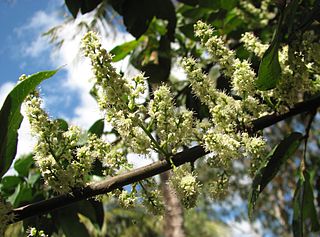
Cupaniopsis is a genus of about 67 species of trees and shrubs of the soapberry family, Sapindaceae. They grow naturally in New Guinea, New Caledonia, Australia, Torres Strait Islands, Fiji, Samoa, Sulawesi, Micronesia. Many species have been threatened with extinction globally or nationally, with official recognition by the International Union for Conservation of Nature (IUCN) and several national and state governments.

Guioa is a genus of about 78 rainforest tree species known to science, which constitute part of the plant family Sapindaceae. They have a wide distribution, ranging from throughout Malesia, in Burma, Cambodia, Vietnam, Thailand, Malay Peninsula, Borneo, Sumatra, Philippines, Java, Flores, Timor, Sulawesi, Moluccas, New Guinea, further southwards through the east coast of Queensland and New South Wales, Australia and further eastwards to the Pacific Islands, including Tonga, New Caledonia, Fiji and Samoa.

Elattostachys is a genus of about 21 species of trees known to science, constituting part of the plant family Sapindaceae.
Astronidium degeneri is a species of plant in the family Melastomataceae. It is endemic to Fiji.
Astronidium is a genus of plants in family Melastomataceae. It contains the following species :
Astronidium floribundum is a species of plant in the family Melastomataceae. It is endemic to Fiji.
Astronidium inflatum is a species of plant in the family Melastomataceae. It is endemic to Fiji.
Astronidium kasiense is a species of plant in the family Melastomataceae. It is endemic to Fiji.
Astronidium pallidiflorum is a species of plant in the family Melastomataceae. It is endemic to Fiji.
Astronidium robustum is a species of plant in the family Melastomataceae. It is endemic to Fiji.
Astronidium saulae is a species of plant in the family Melastomataceae. It is endemic to Fiji.
Astronidium storckii is a species of plant in the family Melastomataceae. It is endemic to Fiji.
Astronidium tomentosum is a species of plant in the family Melastomataceae. It is endemic to Fiji.
Astronidium victoriae is a species of plant in the family Melastomataceae. It is endemic to Fiji.

Geissois imthurnii is a species of forest tree belonging to the plant family Cunoniaceae. It is endemic to Fiji.

Geissois is a genus of trees and shrubs in the plant family Cunoniaceae. It includes about 19 species mostly found in New Caledonia, but also in Fiji, Vanuatu, and the Solomon Islands. Leaves are opposite, palmate with 3-9 leaflets, with entire margin and intrapetiolar stipules. The inflorescences are simple racemes and bottle-brush like. The flowers have four red sepals, lacking petals, with many long red stamens. The fruit is a capsule, the seeds flat and winged. The genus includes several nickel hyperaccumulator and one aluminum hyperaccumulator, Geissois polyphylla.
Geissois stipularis is a species of forest trees, constituting part of the plant family Cunoniaceae. They are endemic to Fiji.
Geissois superba is a species of forest trees, constituting part of the plant family Cunoniaceae. They are endemic to Fiji.

Metroxylon vitiense is a species of flowering plant in the family Arecaceae, endemic to the islands of Fiji, Ovalau, and Vanua Levu in Fiji. There is only one confirmed occurrence of M. vitiense on Vanua Levu, just outside Savusavu. Despite it being considered a threatened species by the IUCN, as of February 2013 M. vitiense was still unprotected by Fijian regulations and international legislation. It has also been reported from the nearby islands of Wallis and Futuna.

Cossinia is a genus of four species of rainforest trees, constituting part of the plant family Sapindaceae. The genus has a disjunct distribution, occurring in Mascarene Islands, Australia, New Caledonia and Fiji.







